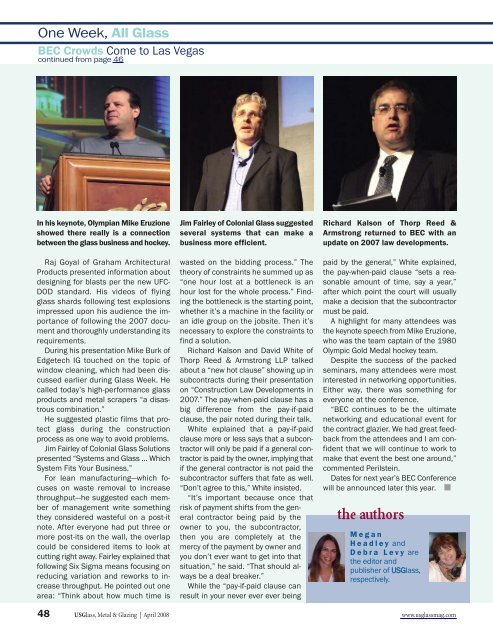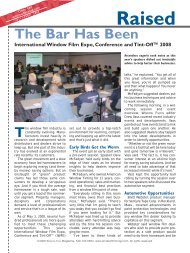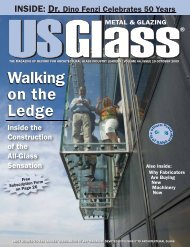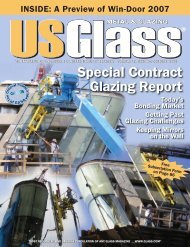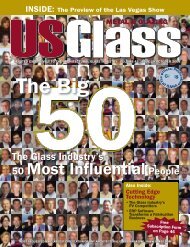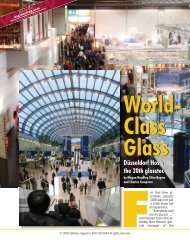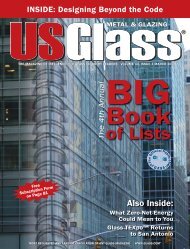US Glass - April 2008 - USGlass Magazine
US Glass - April 2008 - USGlass Magazine
US Glass - April 2008 - USGlass Magazine
Create successful ePaper yourself
Turn your PDF publications into a flip-book with our unique Google optimized e-Paper software.
One Week, All <strong>Glass</strong><br />
BEC Crowds Come to Las Vegas<br />
continued from page 46<br />
In his keynote, Olympian Mike Eruzione<br />
showed there really is a connection<br />
between the glass business and hockey.<br />
Raj Goyal of Graham Architectural<br />
Products presented information about<br />
designing for blasts per the new UFC-<br />
DOD standard. His videos of flying<br />
glass shards following test explosions<br />
impressed upon his audience the importance<br />
of following the 2007 document<br />
and thoroughly understanding its<br />
requirements.<br />
During his presentation Mike Burk of<br />
Edgetech IG touched on the topic of<br />
window cleaning, which had been discussed<br />
earlier during <strong>Glass</strong> Week. He<br />
called today’s high-performance glass<br />
products and metal scrapers “a disastrous<br />
combination.”<br />
He suggested plastic films that protect<br />
glass during the construction<br />
process as one way to avoid problems.<br />
Jim Fairley of Colonial <strong>Glass</strong> Solutions<br />
presented “Systems and <strong>Glass</strong> … Which<br />
System Fits Your Business.”<br />
For lean manufacturing—which focuses<br />
on waste removal to increase<br />
throughput—he suggested each member<br />
of management write something<br />
they considered wasteful on a post-it<br />
note. After everyone had put three or<br />
more post-its on the wall, the overlap<br />
could be considered items to look at<br />
cutting right away. Fairley explained that<br />
following Six Sigma means focusing on<br />
reducing variation and reworks to increase<br />
throughput. He pointed out one<br />
area: “Think about how much time is<br />
Jim Fairley of Colonial <strong>Glass</strong> suggested<br />
several systems that can make a<br />
business more efficient.<br />
wasted on the bidding process.” The<br />
theory of constraints he summed up as<br />
“one hour lost at a bottleneck is an<br />
hour lost for the whole process.” Finding<br />
the bottleneck is the starting point,<br />
whether it’s a machine in the facility or<br />
an idle group on the jobsite. Then it’s<br />
necessary to explore the constraints to<br />
find a solution.<br />
Richard Kalson and David White of<br />
Thorp Reed & Armstrong LLP talked<br />
about a “new hot clause” showing up in<br />
subcontracts during their presentation<br />
on “Construction Law Developments in<br />
2007.” The pay-when-paid clause has a<br />
big difference from the pay-if-paid<br />
clause, the pair noted during their talk.<br />
White explained that a pay-if-paid<br />
clause more or less says that a subcontractor<br />
will only be paid if a general contractor<br />
is paid by the owner, implying that<br />
if the general contractor is not paid the<br />
subcontractor suffers that fate as well.<br />
“Don’t agree to this,” White insisted.<br />
“It’s important because once that<br />
risk of payment shifts from the general<br />
contractor being paid by the<br />
owner to you, the subcontractor,<br />
then you are completely at the<br />
mercy of the payment by owner and<br />
you don’t ever want to get into that<br />
situation,” he said. “That should always<br />
be a deal breaker.”<br />
While the “pay-if-paid clause can<br />
result in your never ever ever being<br />
Richard Kalson of Thorp Reed &<br />
Armstrong returned to BEC with an<br />
update on 2007 law developments.<br />
paid by the general,” White explained,<br />
the pay-when-paid clause “sets a reasonable<br />
amount of time, say a year,”<br />
after which point the court will usually<br />
make a decision that the subcontractor<br />
must be paid.<br />
A highlight for many attendees was<br />
the keynote speech from Mike Eruzione,<br />
who was the team captain of the 1980<br />
Olympic Gold Medal hockey team.<br />
Despite the success of the packed<br />
seminars, many attendees were most<br />
interested in networking opportunities.<br />
Either way, there was something for<br />
everyone at the conference.<br />
“BEC continues to be the ultimate<br />
networking and educational event for<br />
the contract glazier. We had great feedback<br />
from the attendees and I am confident<br />
that we will continue to work to<br />
make that event the best one around,”<br />
commented Perilstein.<br />
Dates for next year’s BEC Conference<br />
will be announced later this year. ■<br />
Megan<br />
Headley and<br />
Debra Levy are<br />
the editor and<br />
publisher of <strong>US</strong><strong>Glass</strong>,<br />
respectively.<br />
48 <strong>US</strong><strong>Glass</strong>, Metal & Glazing | <strong>April</strong> <strong>2008</strong> www.usglassmag.com


